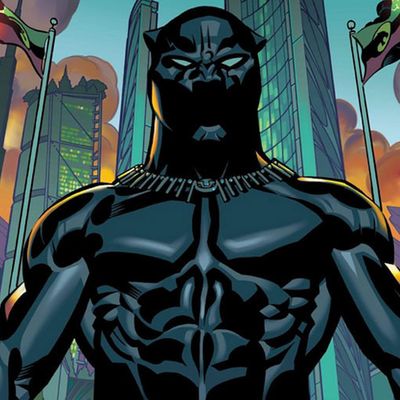
After months of waiting, one of the most hotly anticipated comic books of recent years has arrived: Black Panther No. 1, as authored by superstar nonfiction writer and longtime geek Ta-Nehisi Coates. Publisher Marvel Comics announced in September that Coates — writer of the acclaimed Between the World and Me — would be penning the monthly comics series, with artwork from veteran penciler Brian Stelfreeze. The specifics of the narrative were kept under wraps, but one thing was certain: A lot of people who were fans of Coates and not necessarily fans of comics would be picking up this issue.
Now that it’s here, you might be surprised at how steeped it is in references to past Black Panther stories. In an interview from his home in Paris, Coates says he just wanted “to tell a really, really good story,” and given his love of Marvel’s rich history, he drew on a lot of what had gone before. So in order to clarify anything that might be confusing, we asked Coates to help us annotate the issue, page by page. If something isn’t annotated here, that’s because it’s explained within the issue or is a new concept or character with no preexisting background information. Let the continuity-mining begin!
Page 1
Wakanda
Let’s start with the setting, since almost everything in the issue flows from there. Wakanda is a fictional, technologically advanced African nation that was never taken over by European colonialists. It’s recently been through some hardships, which will be enumerated later. “The country’s been devastated a few times,” says Coates. “This is a country whose identity was, We’ve never been conquered. We’re Wakanda the invincible, Wakanda the unbreakable. The fact of the matter is, over the past few years, you’ve seen Wakanda broken several times, and so the question is, What is Wakanda now?”
T’Challa/Black Panther
Our protagonist. The character first appeared in the pages of Fantastic Four in 1966 and has been a mainstay ever since, often using his genius intellect and fighting prowess alongside other Marvel superheroes. The role and costume of the Black Panther is one given to Wakanda’s monarchs. “He’s the king of Wakanda. I think in past portrayals, he’s been portrayed as very proud of what Wakanda is and a very, very proud man. My T’Challa is probably less proud and probably has less of that arrogance with him, and that’s probably because I always found the pride and the arrogance distancing.”
After temporarily losing the throne to his sister (we’ll get into that below), a Wakandan god made him the first “King of the Dead,” a mystical role that allowed him to commune with his ancestors. He still has that role, but is once again the ruler of Wakanda, too. He’s had a rough few years. “He still has confidence. He’s not a broken dude. He’s still very, very clear on what he’s capable of and what he’s doing, but I think he’s much more interested in what it means to be a king. I think he’s much more interested in why he’s a king. I think he’s much more interested in whether he should be a king. I think he’s much more interested in what his relationship to Wakanda actually should be.”
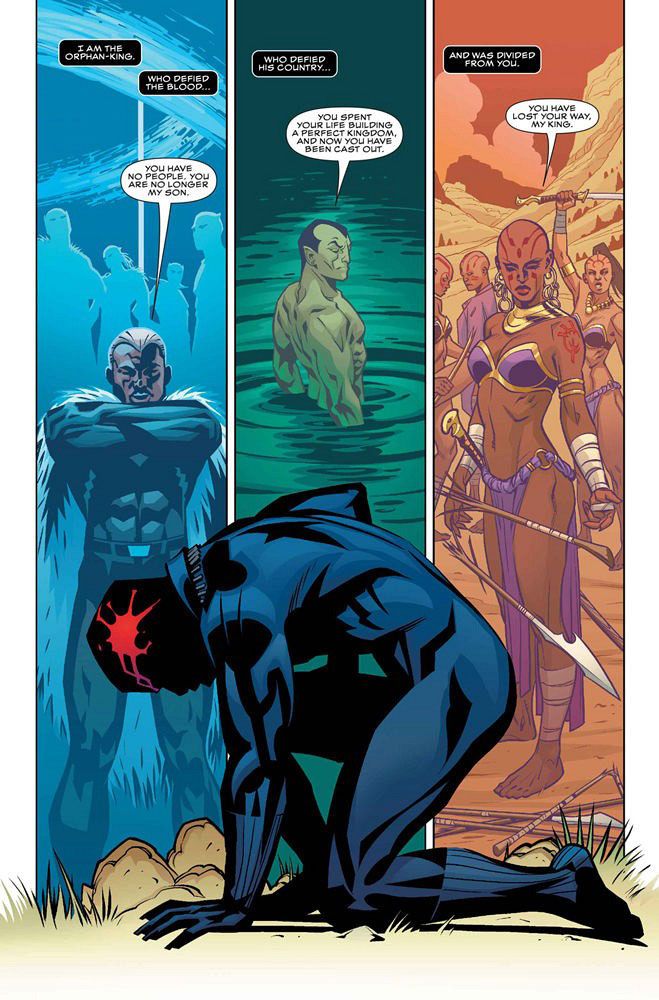
T’Chaka (left background figure, above)
T’Challa’s late father, the previous king of Wakanda and previous holder of the Black Panther mantle, appears in the first panel. It’s a re-creation of a scene from a recent Black Panther story. “T’Challa basically has the ability to communicate with his ancestors, all people who have been Black Panthers before. There’s a very, very moving conversation between T’Challa and his ancestors in which they urge him to really do whatever he has to do to protect Wakanda, however immoral it is. This comes to the point where he’s basically told to destroy another planet to save Earth. He says he’ll do it under the influence of his ancestors, but when time comes to do it, he can’t. He can’t bring himself to do it. Because he can’t, he’s kicked out. His father basically says, ‘You’re not my son.’ His ancestry is severed. I thought that had to be pretty painful.”
Namor (middle figure, above)
The ruler of the underwater kingdom of Atlantis and a longtime Marvel anti-hero. While under the influence of alien intelligence, he flooded Wakanda, killing many. But afterward, T’Challa worked with him on a secret team of superpowered individuals. “The second panel is from a moment when T’Challa is discovered to actually be cooperating with Namor, who is a complete enemy of Wakanda for having flooded the country. This enemy of Wakanda is the person that he ends up talking to. He says, ‘You’ve spent your life building a perfect kingdom, and now you’ve been cast out.’ The notion is that he’s been pushed out again.”
The Dora Milaje (right figure, above)
Wakanda’s elite, all-female squadron of royal bodyguards. They appear in yet another flashback. “The third panel is a moment that precedes [the Namor moment], and it is when the Dora Milaje reject him. That’s when it’s discovered that, in fact, he’s been working with Namor, and they say, ‘You have lost your way, my king. You have lost your soul.’ So he’s king now, right, but he’s experienced this rejection.”
“I’ve always seen the Dora Milaje as a bit problematic, and that’s going to divide me from most fans of the Black Panther. One of them is taken from every tribe in Wakanda and brought in, and T’Challa has the option of taking one of them as a wife. [I don’t like] the idea of these scantily clad bodyguards for this dude who’s the king and the notion that he doesn’t abuse that or that this is okay. I wanted to do something different. I try to see them as independent people and not people who we see strictly through the gaze of the male comic-book fans.”
Page 2
The Great Mound
“The Great Mound is a mountain where all the vibranium is, and vibranium is the resource that gives Wakanda much of its wealth.”
Page 4
Wakandan language
Unlike Klingon or Dothraki, there’s no official version of the fictional Wakandan language. In this story, we mostly see it translated into English, but there are a few words Coates wanted to play around with in untranslated form. It resembles real languages, but don’t bother trying to find literal translations of the Wakandan terms. “I could have created a Wakandan language from scratch, but the idea is that Wakandan, as represented to the reader, pulls from a variety of African languages. [The language is] imagined as an amalgam. I think there’s a little bit of Hausa in there. There might be some Swahili in there. There might be a little bit of Shona in there.”
Page 7
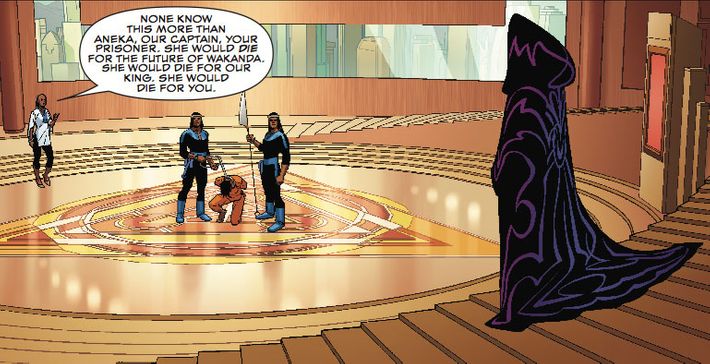
The Golden City
“The Golden City is the capital of Wakanda. This is Washington and New York. This is the Paris of Wakanda. It will probably not have that name by issue 13. Neither will the Great Mound. All that stuff’s going to be Africanized.”
Aneka
“She’s the captain of a group of Dora Milaje. She eventually became the leader of this group called the Midnight Angels. It’s supposed to be an even more crack group of Dora Milaje.”
Shuri
T’Challa’s late sister. After an assassination attempt on T’Challa, she became Queen of Wakanda and another, simultaneously operating Black Panther. But in a recent story, she was killed and T’Challa returned to the throne. “Their relationship was broken at the point that she died. Basically, she was pissed off at him. There were various times where T’Challa would try to counsel her to not go to war with Atlantis; she did it anyway. When she found out T’Challa was scheming with Namor, she basically cast him out.”
Ramonda (the robed woman)
One of the late T’Chaka’s wives and mother of Shuri, but not T’Challa. “Ramonda is T’Challa’s mother, although not his birth mother. But she’s the woman he considers to be his mother. She married T’Challa’s father. She had a very important role; she basically ruled in his stead. She’s been an adviser. She’s an elder there.”
Kimoyo
“Kimoyo is something that my predecessor, [past Black Panther writer] Christopher Priest, came up with. He had a Kimoyo Card, which is almost like this smartphone-in-a-card that Black Panther used. We changed it a little bit and turned it into a band that all Wakandans have, and they do different things depending on who the Wakandan is. Obviously, if you’re king, yours does a lot more.”
Page 10
N’Yami/T’Challa’s mother
She was one of T’Chaka’s wives, and she died in childbirth.
Death of T’Chaka
He refused to grant first-world economies access to Wakanda’s vibranium, and a cabal of powerful operatives had him assassinated.
Page 11
Soul-Stalker technology
“T’Challa has heightened senses. That’s one of his powers, but I think it’s one that hasn’t been used as much as it could be. I definitely wanted to use more of that, but I thought one way you could do it is, what if all of those things came together and allowed for another sense, a heightened sense taken together with something bigger than that, something almost spiritual? It’s like a sixth sense.”
Page 12
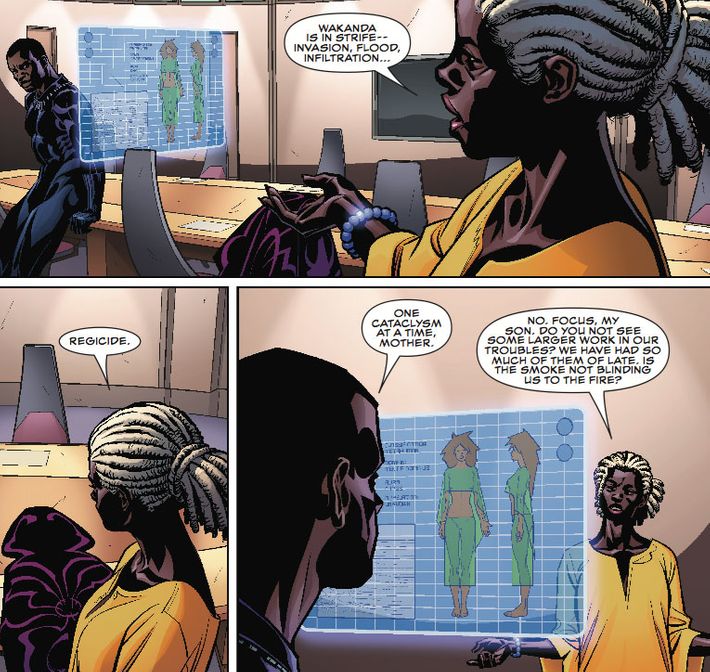
“Invasion”
Though Wakanda prides itself on never being invaded by colonial powers, it was recently invaded and crushed by a sinister group of intergalactic supervillains called the Black Order. One of them killed Shuri. They’ve since been run out, but the psychological damage was done.
“Flood”
The aforementioned flooding at the hands of Namor.
“Infiltration”
Longtime Marvel supervillain Doctor Doom recently engineered an unsuccessful but very public coup within Wakanda.
“Regicide”
The death of Shuri.
Page 15
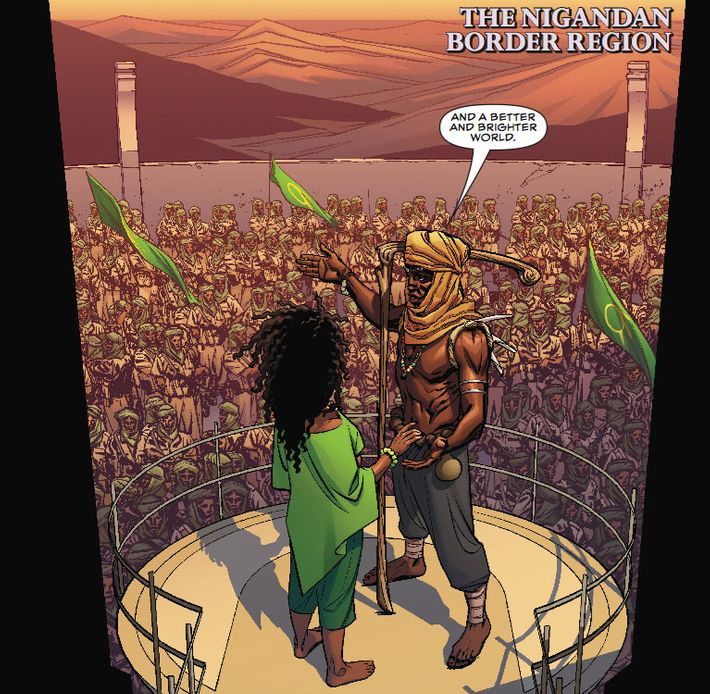
Niganda
“Niganda is a country that neighbors Wakanda, and they have not been as fortunate in history as Wakanda has. [Black Panther nemesis] Killmonger [in a recent story] tried to organize the Nigandans to basically overthrow T’Challa and take over Wakanda. It’s a poorer country.”
If you’re looking for further reading, Coates recommends the story that is “most immediate” to his run with the character: writer Jonathan Hickman’s 33-issue series New Avengers, which ran from 2013 to 2015 and prominently featured many of the events referenced in this first issue. And if you like or don’t like this issue, Coates has a helpful guide on who to blame: “Listen, if this sucks, it’s me; and if it’s great, it’s Brian [Stelfreeze]. Even though I’m joking, I kind of mean that, because Brian, he’s just made this look so beautiful.”

